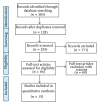Obesity as a risk factor for tendinopathy: a systematic review
- PMID: 25214839
- PMCID: PMC4156974
- DOI: 10.1155/2014/670262
Obesity as a risk factor for tendinopathy: a systematic review
Abstract
Purpose. In the last few years, evidence has emerged to support the possible association between increased BMI and susceptibility to some musculoskeletal diseases. We systematically review the literature to clarify whether obesity is a risk factor for the onset of tendinopathy. Methods. We searched PubMed, Cochrane Central, and Embase Biomedical databases using the keywords "obesity," "overweight," and "body mass index" linked in different combinations with the terms "tendinopathy," "tendinitis," "tendinosis," "rotator cuff," "epicondylitis," "wrist," "patellar," "quadriceps," "Achilles," "Plantar Fascia," and "tendon." Results. Fifteen studies were included. No level I study on this subject was available, and the results provided are ambiguous. However, all the 5 level II studies report the association between obesity measured in terms of BMI and tendon conditions, with OR ranging between 1.9 (95% CI: 1.1-2.2) and 5.6 (1.9-16.6). Conclusions. The best evidence available to date indicates that obesity is a risk factor for tendinopathy. Nevertheless, further studies should be performed to establish the real strength of the association for each type of tendinopathy, especially because the design of the published studies does not allow identifying a precise cause-effect relationship and the specific role of obesity independently of other metabolic conditions.
Similar articles
-
Obesity Increases the Risk of Tendinopathy, Tendon Tear and Rupture, and Postoperative Complications: A Systematic Review of Clinical Studies.Clin Orthop Relat Res. 2020 Aug;478(8):1839-1847. doi: 10.1097/CORR.0000000000001261. Clin Orthop Relat Res. 2020. PMID: 32732565 Free PMC article.
-
Autologous growth factor injections in chronic tendinopathy.J Athl Train. 2014 May-Jun;49(3):428-30. doi: 10.4085/1062-6050-49.3.06. Epub 2014 May 19. J Athl Train. 2014. PMID: 24840581 Free PMC article.
-
The Efficacy of Platelet-Rich Plasma on Tendon and Ligament Healing: A Systematic Review and Meta-analysis With Bias Assessment.Am J Sports Med. 2018 Jul;46(8):2020-2032. doi: 10.1177/0363546517743746. Epub 2017 Dec 21. Am J Sports Med. 2018. PMID: 29268037 Free PMC article.
-
Effectiveness of topical glyceryl trinitrate in treatment of tendinopathy - systematic review and meta-analysis.Disabil Rehabil. 2022 Oct;44(20):5804-5810. doi: 10.1080/09638288.2021.1958067. Epub 2021 Jul 30. Disabil Rehabil. 2022. PMID: 34330192
-
Real-time sonoelastography: principles and clinical applications in tendon disorders. A systematic review.Muscles Ligaments Tendons J. 2018 Jan 10;7(3):467-477. doi: 10.11138/mltj/2017.7.3.467. eCollection 2017 Jul-Sep. Muscles Ligaments Tendons J. 2018. PMID: 29387640 Free PMC article.
Cited by
-
Risk factors for surgery due to rotator cuff disease in a population-based cohort.Bone Joint J. 2020 Mar;102-B(3):352-359. doi: 10.1302/0301-620X.102B3.BJJ-2019-0875.R1. Bone Joint J. 2020. PMID: 32114822 Free PMC article.
-
Grape seed proanthocyanidin extract alleviates high-fat diet induced testicular toxicity in rats.RSC Adv. 2019 Apr 16;9(21):11842-11850. doi: 10.1039/c9ra01017c. eCollection 2019 Apr 12. RSC Adv. 2019. PMID: 35517006 Free PMC article.
-
The Association of Body Mass Index and Achilles Tendon Rupture: A Retrospective Case-Control Study.Foot Ankle Orthop. 2025 Mar 24;10(1):24730114251327212. doi: 10.1177/24730114251327212. eCollection 2025 Jan. Foot Ankle Orthop. 2025. PMID: 40144532 Free PMC article.
-
Sarcopenia in Endocrine Disorders - The Iceberg or Its Tip?Eur Endocrinol. 2015 Apr;11(1):41-42. doi: 10.17925/EE.2015.11.01.41. Epub 2015 Apr 11. Eur Endocrinol. 2015. PMID: 29632567 Free PMC article.
-
Diagnostic Accuracy of Shear Wave Elastography Versus Ultrasound in Plantar Fasciitis Among Patients with and Without Ankylosing Spondylitis.Diagnostics (Basel). 2025 Aug 5;15(15):1967. doi: 10.3390/diagnostics15151967. Diagnostics (Basel). 2025. PMID: 40804931 Free PMC article.
References
-
- Battery L, Maffulli N. Inflammation in overuse tendon injuries. Sports Medicine and Arthroscopy Review. 2011;19(3):213–217. - PubMed
-
- Del Buono A, Battery L, Denaro V, Maccauro G, Maffulli N. Tendinopathy and inflammation: some truths. International Journal of Immunopathology and Pharmacology. 2011;24(1) supplement 2:45–50. - PubMed
-
- Sharma P, Maffulli N. Tendon injury and tendinopathy: healing and repair. The Journal of Bone & Joint Surgery A. 2005;87(1):187–202. - PubMed
Publication types
LinkOut - more resources
Full Text Sources
Other Literature Sources
Medical


